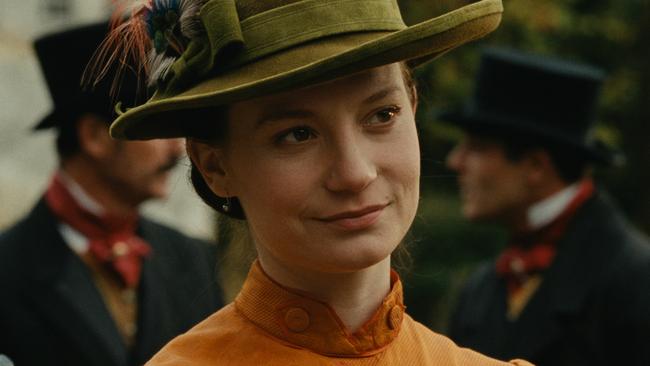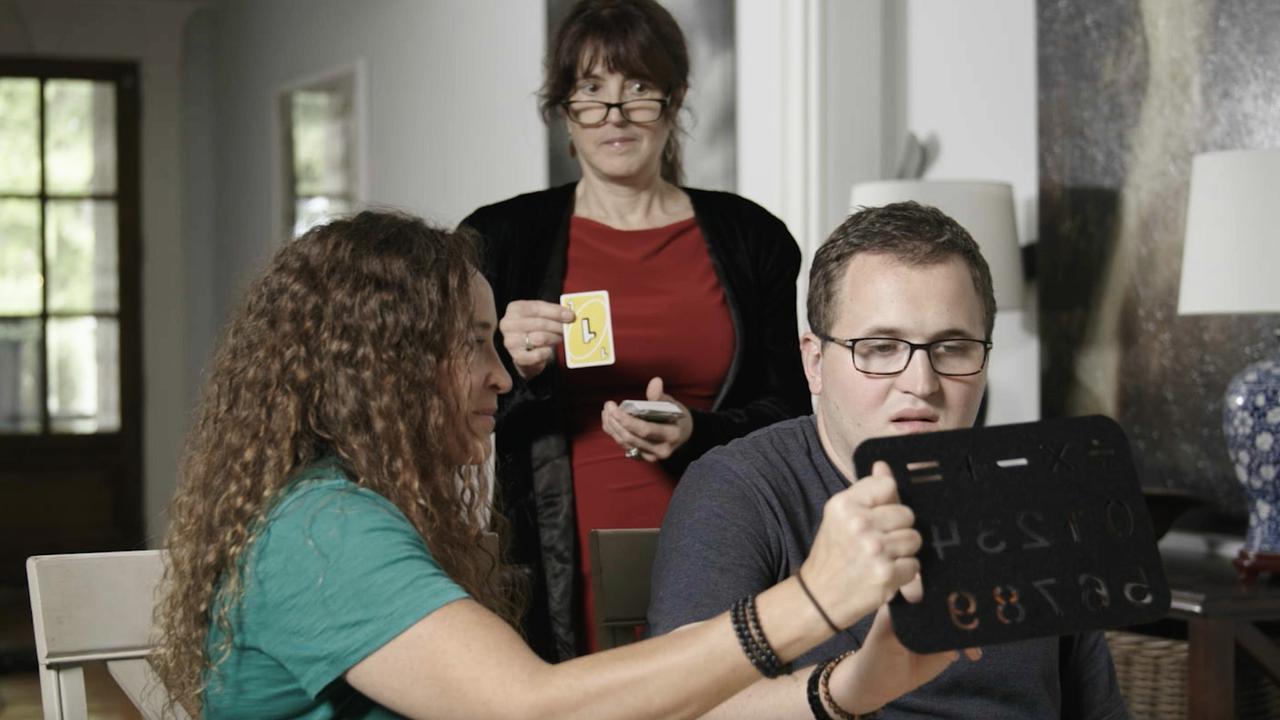Madame Bovary’s screen return — a touch of Fifty Shades of Grey
Mia Wasikowska is the latest in a long list of stars to have reinvented Flaubert’s timeless character Emma Bovary.

Gustave Flaubert’s Madame Bovary is one of the great novels. Its legacy is everywhere as new readers continue to discover it, book clubs (such as the one Kate Winslet visits in Todd Field’s Little Children) make it their classic of choice, and a wide variety of filmmakers, writers and others from around the globe revisit it. For better or worse, as Daphne Merkin of Elle put it in 2010, it is also the novel of choice for “every woman who has felt that prosaic reality isn’t quite what she bargained for, that marriage is a let-down, and that her specialness goes unappreciated”.
The latest big-screen adaptation, by Sophie Barthes and starring Canberra-born actress Mia Wasikowska, opened in Australia this week.
FILM REVIEW: David Stratton’s verdict on Madame Bovary
First published in serial form in the Revue de Paris in 1856 and largely set in and around Rouen in rural Normandy, Flaubert’s debut novel tells the story of what happens to impressionable young Emma Roualt when she becomes Madame Bovary. Her transformation from dreamy farmer’s daughter to the wife of decent but dull country doctor Charles Bovary is tantamount to a prison sentence, the novel’s title itself suggesting the erasure of her sense of self. Her unhappiness and her attempts to escape her misery are the book’s driving force; Flaubert skilfully filters a scathing critique of the mercenary world around her through her experiences of it.
In the century and a half since it was published, it has been a recurring reference point for a wide variety of cinematic admirers. David Lean’s Ryan’s Daughter (1970) and Manoel de Oliveira’s Abraham’s Valley (1993) were both originally planned as straight adaptations of the novel, but then morphed into very different kinds of variations. Woody Allen’s 1977 short story The Kugelmass Episode (in Side Effects) has a neurotic literature professor taking a grand leap into the fictional world of the novel where Emma awaits. Posy Simmonds’s modernised borrowing, the graphic novel Gemma Bovery (1999), was perfunctorily adapted to the screen last year by French filmmaker Anne Fontaine. Starring Gemma Arterton in the title role, it also featured Fabrice Luchini as the Woody Allen-like village baker who falls under her spell.
Isabelle Huppert notes the connection between Flaubert’s heroine and the cattle farmer’s wife she plays in Folies Bergere (2014), Marc Fitoussi’s gorgeous variation on the novel.
“She is a bored woman, like Emma Bovary, especially since the movie takes place in Normandy,” says the actress. “But she has no guilt. She fully enjoys her escapade. There is no blame or dispute between her and her husband, just a form of weariness with everyday life that needs to be shaken.”
And it appears the novel is even lurking around somewhere in the background of Fifty Shades of Grey (2014). In Vanity Fair earlier this year, the film’s co-producer Michael De Luca laid claim to it, along with all the other novels he had ever read about “female characters in various states of either sexual oppression or awakening”, as the reason why he had wanted to adapt EL James’s novel. “I go right back to Madame Bovary,” he enthused. “I read it in high school, and it was my favourite book.”
Beyond the novel being reworked or referred to, there are at least seven full-fledged direct adaptations for the big screen and at least half a dozen more for television, either as telemovies or miniseries. The most notable of them have been by directors Jean Renoir in 1934 (with Valentine Tessier as Emma), Vincente Minnelli in 1949 (with Jennifer Jones), Claude Chabrol in 1991 (with Huppert), and now Barthes.
While the idea of a direct adaptation raises the issue of fidelity in a way that other uses of the novel do not, it should be noted the notion is nonsense. Short of actually presenting the book on screen and having someone turn the pages, it’s difficult to work out exactly how any film could be faithful to a novel.
To what would it be faithful anyway? The plot, the characters, the themes, the tone, the perspective it brings to its story?
Rather than having some nebulous obligation to be faithful to a novel from which they’ve adapted their work, filmmakers should simply be required to make a good film, or even a masterpiece: neither of which, of course, is ever a simple matter.
Nonetheless, adapting a novel as acclaimed as Flaubert’s takes some gumption.
So, for Barthes, another remake of Madame Bovary didn’t immediately spring to mind as a follow-up to her Faustian feature debut, Cold Souls, a dryly funny, Allen-esque piece about an actor (Paul Giamatti) trying to improve his performance in Uncle Vanya by borrowing the soul of a Russian poet.
“I received Felipe Marino’s script from my agency,” she explains from her New York base in her softly spoken, French-accented way, “and my first reaction was to wonder why I would want to do that. There had been all of these other versions and I didn’t even want to read it. But then it became a bit like Pandora’s box, and once I opened it I found that I liked the take and realised I could still relate to her as a character, not only because I’m French but because she embodies a condition that is very contemporary”.
Barthes hasn’t read The Kugelmass Episode, but had initially thought that maybe she could allow Allen to be her muse again. “In Love and Death he does that parody of Russian literature, and I thought at one point we should do our Madame Bovary like this.” But that idea was quickly abandoned with her realisation that Flaubert’s concerns in the novel were guiding her in other directions.
To the suggestion that perhaps it’s the Faustian elements in Madame Bovary — Emma selling her soul to the unctuous merchant Monsieur Lheureux — that drew her to the project, Barthes laughs. “Maybe unconsciously. It’s thematically true,” she says. “But, you know, when you’re French you grow up with Flaubert. It’s required reading. This book always stayed with me and I felt that as I read it differently at different ages, I grew as a reader. As a teenager, I read it for the wrong reasons. And after marriage [to her regular cinematographer Andrij Parekh] and having a child, I read it completely differently. That’s what continues to interest me about the book.”
She didn’t spend time looking at the other film versions because she wanted to be free of the perceived need to do things differently. “I had seen the Chabrol a while ago,” she says. “But I didn’t want to go back and watch the Renoir and the Minnelli just so that I would do things just for the sake of doing them. I wanted to come at my film fresh.”
A couple of the choices she made about how to tell her story are radically different from the ones others have made. Her Madame Bovary begins at the end of Emma’s life, casting what follows as a flashback.
“This came about in the editing process,” Barthes reveals. “I thought it was important to build a context for an audience that mightn’t know the book and how tragic the ending is. I wanted to create a black cloud around her so that the audience knows that every one of her actions and everything she does is bringing her closer to her death. It set the right tone: we know she’s going die but what’s going to lead her to that point?”
As a result, Emma is constantly at the centre of the story. Whereas the novel begins largely from husband-to-be Charles’s point of view and then gradually shifts perspective about 50 pages in, Barthes abandons this approach, locking us inside Emma’s consciousness right from the start and keeping us there. Even when her actions become increasingly alienating.
“When I first got the script,” the filmmaker recalls, “one thing that I really liked was that it started with the wedding. Flaubert said in his correspondence that he thought Emma was a little bit like Sleeping Beauty, and there’s a lot of symbolic fairytale elements in the book. So, in the movie, she pricks her finger at the wedding and it’s like she’s been condemned to 100 years of boredom.”
The other significant variation in Barthes’s version is the insertion of a deer hunt — perhaps inspired by the rabbit hunt in Renoir’s masterpiece The Rules of the Game (1939) — which brings Emma face-to-face with the dark side of her dreaming. Its equivalent in Minnelli’s version is the exhilarating ballroom sequence, in which she loses herself to the fantasy of playing Cinderella to the caddish Rodolphe’s Prince Charming.
As far as Barthes was concerned, the decision not to follow Minnelli’s lead was an easy one. “At one point we simply didn’t have the resources to make the film,” she points out, “so I had to make some drastic choices. I didn’t really want to shoot the ball scene because it would take such a long time and I felt it could end up being very cliched. I thought a hunt would be symbolically stronger: the Marquis hunting her and the deer.”
And for Barthes the 25-year-old Wasikowska was the perfect choice to play her Emma.
“I had been watching her work since the HBO series In Treatment,” she says, “and I have always really liked her as an actress because I think there are few actresses of her age who have such amount of wisdom and so many layers.
“On screen, she’s very ambiguous. You never quite know what she’s thinking. There’s this quality: you can’t really grasp her. For me, she’s very enigmatic, and I love that.”
Madame Bovary is showing across Australia.


